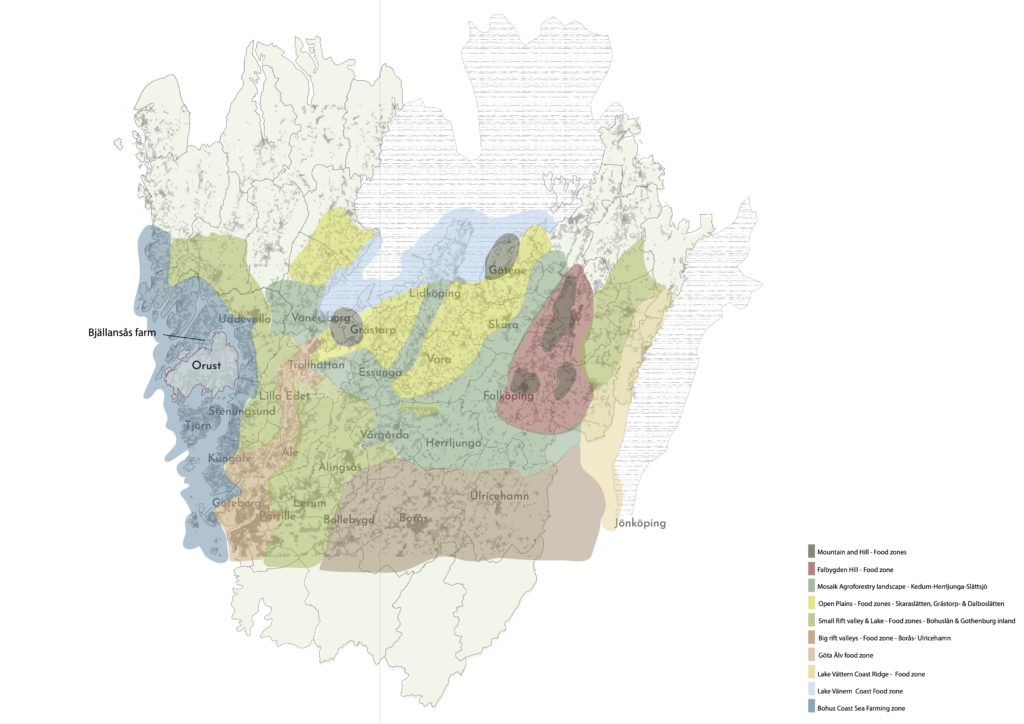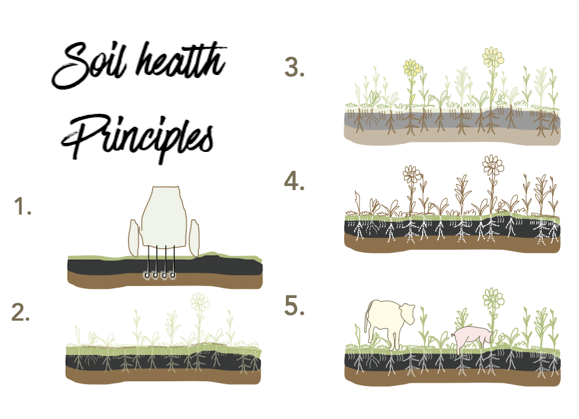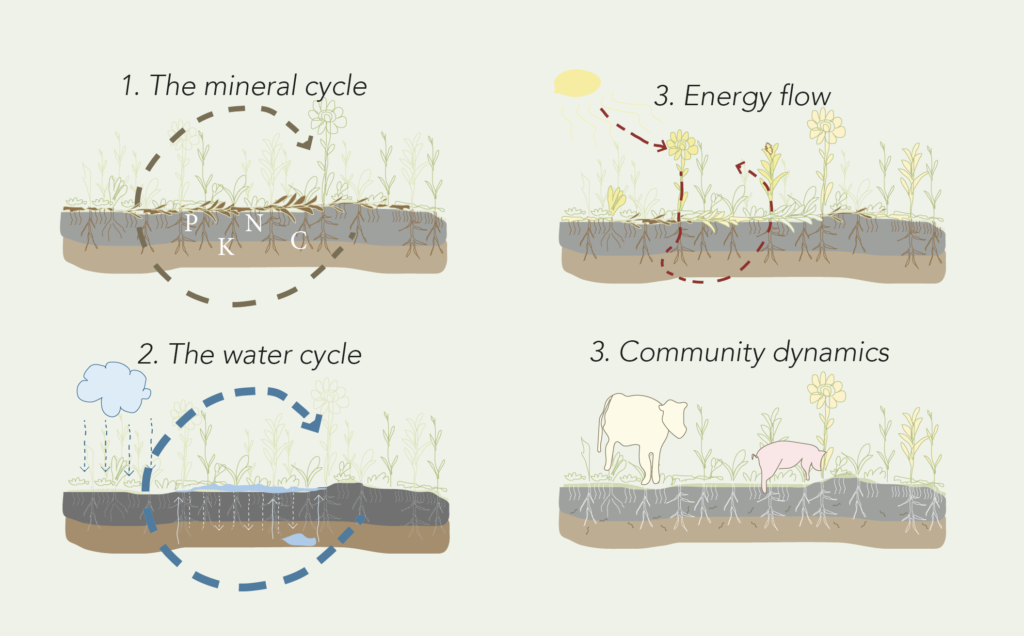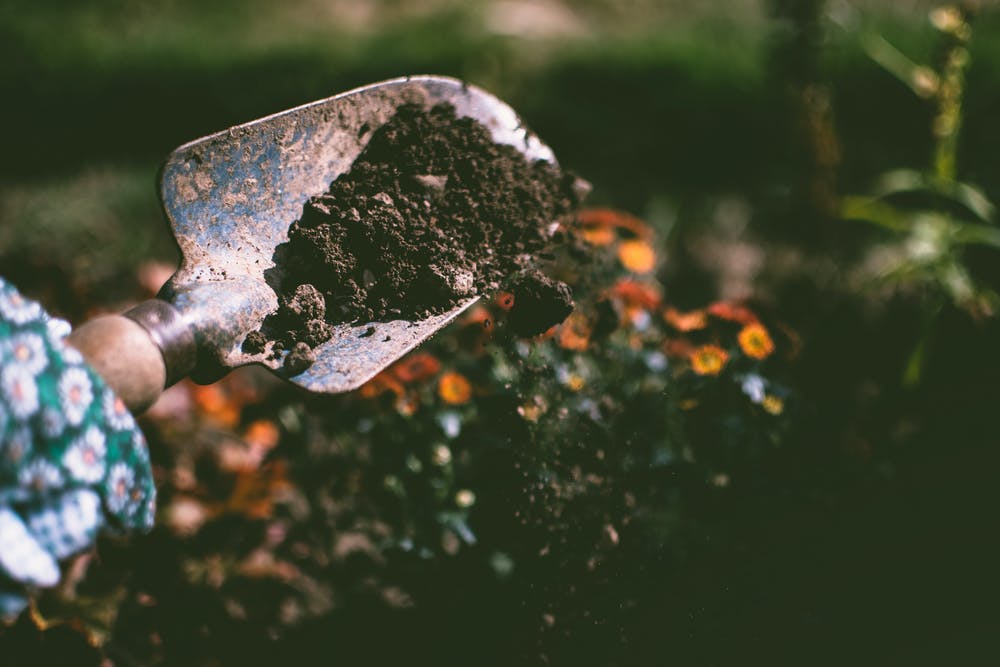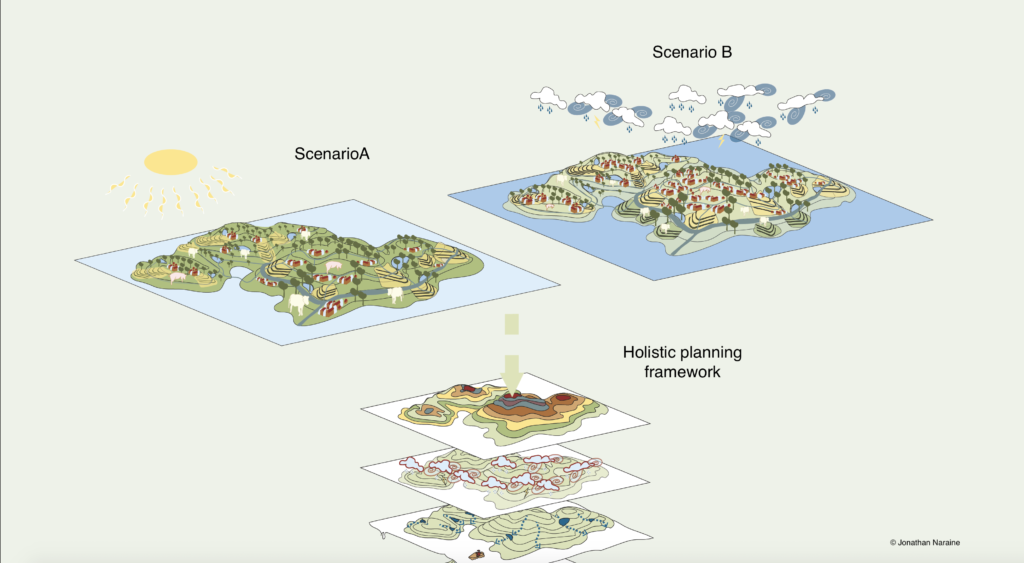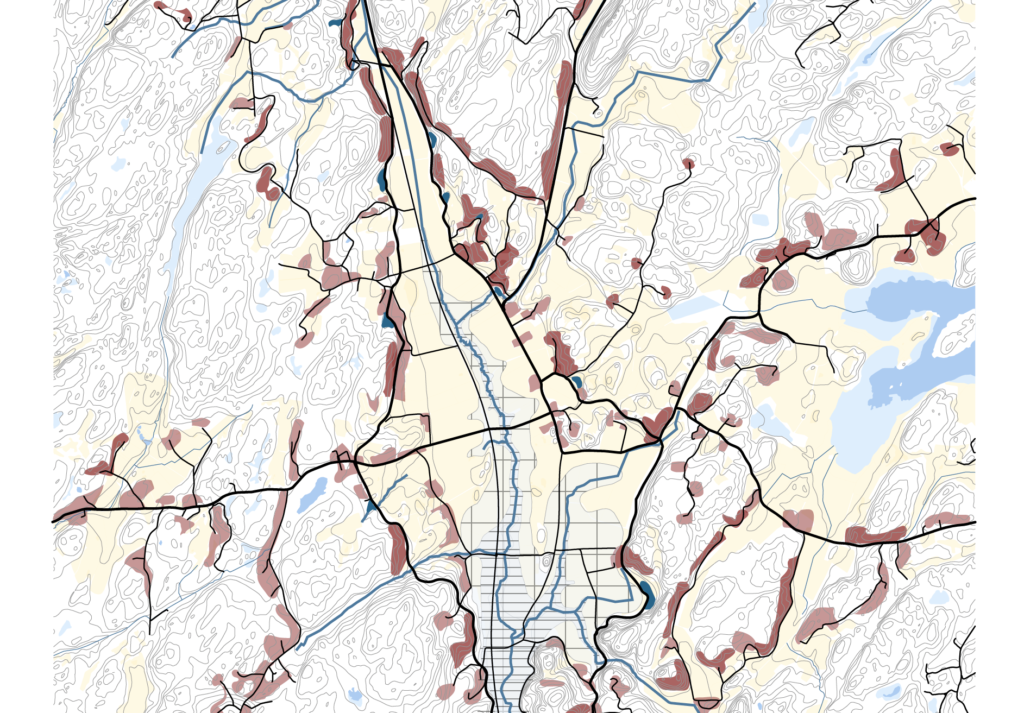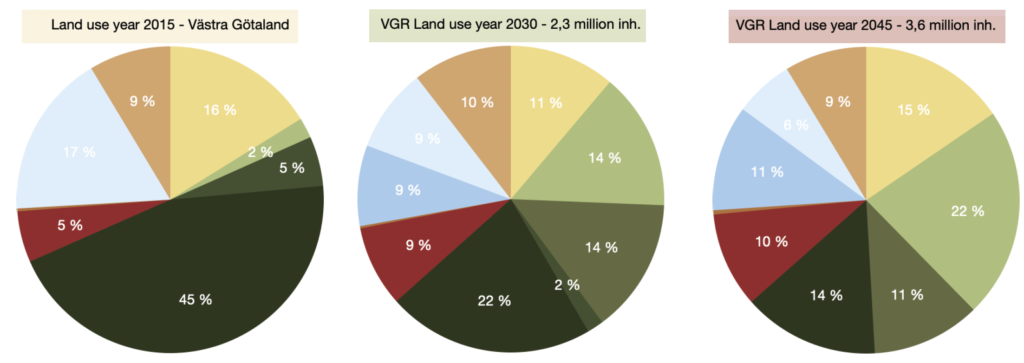News
Carbon positive food regions & Food system design – Part 2

Can a region sequester more carbon in the soil than is emitted by all consumption of its inhabitants? What can cities, regions and governments do to design carbon positive food regions? Why is it important to support regenerative agriculture and build more local resilient food systems? What are the 6 regenerative planning principles? How will these regenerative food systems look like 5-10 years from now? What larger social, environmental impacts can be expected and what is need to get here? In this article Jonathan shares the key take aways and planning strategies from his master’s thesis “Carbon positive food regions” published at Chalmers University of Technology in June 2022.
Carbon positive food regions – Key take aways
This spring Jonathan has been finishing his Master Thesis in Architecture and Planning on the topic of Food System Design and how we can co-create “Carbon positive food regions”, which is also the title of his thesis. Below you will find some of the key takeaways from the thesis work with tips on how architects, planners and designers can create more local and regenerative food systems.
Can a region sequester more carbon in the soil than is emitted by all consumption of its inhabitants?
This question we asked in part 1 of this blog series Co-designing Carbon Positive Food Regions – Part 1. In this first blog article on the theme Jonathan introduced the ideas behind his master thesis during the spring. But now let’s explore the results and final take aways from the thesis. Below you’ll find the interview where international blog “Agritecture” interviewed Jonathan this August. Previously this spring Agritecture also wrote a blogpost about the Grow Here platform and our work with creating more local food systems, read it here.
Let’s dive into the interview!
1. How do you define “carbon-positive food regions?
Well this is a very interesting question indeed. In my Master’s thesis I define both Carbon Positive and Food regions or Food systems to give a greater understanding of what this means. Let’s start with “Food regions” of “Regional food systems”, what does that actually mean…? Well, many regions struggle with defining what is “local food”. How many food miles can we allow for the food to be considered local? Perhaps it is all about having a close relation to the food and I personally believe ”food regions” and ”local food” can be defined in different scales by setting some boundaries such as distance, relationship with the farmer etc.
I have taken inspiration from how Trafikverket (2015) identifies the main types of geological land conditions in the region of Västra Götaland. These very much influence our ability to grow different types of food here and I personally use them as a basis for defining larger food regions. I believe these geological regions will likely specialize in certain foods. F.ex. ocean farming in the case of “Bohus coast”, field crop farming in the case of the “Open plains” of Skara, Grästorp and Dalboslätten and the Mosaik landscape will likely have more grazing animals. See the illustration below where the different potential food regions of Västra Götaland are visualized:
– What types of agricultural practices does this term embody (e.g. regenerative farming)?
Regenerative agriculture is one of the most exciting topics of our time. In short it is a way of farming where the outcome goes beyond being just “sustainable” (meaning doing less bad) to actually having a truly positive and “regenerative” impact on ecosystems, social systems and local economies. Regenerative agriculture is not really a method of farming like organic where you avoid chemicals, etc. Even if it is usually described as such the key to defining it lies in the meaning of regenerating. Regenerative agriculture is more of an outcome towards regeneration of soil, ecosystems and communities. However there are some principles and frameworks we can use to better understand how to get here. Let’s dive into these.
First let’s have a look at soil health – the basis of life in so many ecosystems!
5 principles of soil health:
- Limited disturbance:
Reduce tilling as it disturbs soil structures, resulting in soil erosion. Chemical pesticides and fertilizers also disturb the soil. - Armor:
Nature always works to cover the soil and protects it from wind and water erosion. F.ex. dead organic matter breaking down or living cover crops creates this armor on the soil. - Diversity:
Avoid monocultures and strive for diversity. Integrate many species of plants with varying root depths and niches as it feeds a variety of microbes in the soil. - Living roots:
Maintain a living root in the soil as long as possible. Green growing plants means living roots, feeding soil biology by providing its basic food source – carbon. - Integrating livestock:
Grazing animals stimulates plants to pump more carbon into the soil. This drives nutrient cycling by feeding biology. It’s also important to provide habitat for all fauna, birds, insects and microbiology.
(Brown, 2018. 2min 30)
Soil – the foundation of life
Using these principles means we try to build soil and nurture the microbes in the soil. And soil carbon is deeply linked with soil microbes. The great numbers and diversity of microbes in the soil, the more carbon and humus can be stored, and the more water infiltrated. This has many benefits for both climate change mitigation and adaption as well as increasing biodiversity in soil and above soil. Soil life is the foundation of all life on land according to farmer Gabe Brown (Qwiberg, 2017, Brown, 2018). In fact both you and I are made up of microbes that originate from living soil. Did you know that 90% of our DNA is actually not human DNA but that of our microbiome living within us. Many thus believe human health to also be connected to the health of the soil.
Soil health, plant health, animal health, human health, planet health – all interlinked through soil carbon.
Illustration of the 4 ecosystem processes – ©Jonathan Naraine
The ecosystem processes
So how do we ensure soil is regenerated and not lost, how do we know ecosystems are revitalised? Four important processes govern the regenerating of land based ecosystems – these are called the Ecosystem processes. These processes all influence each other in positive or negative spirals and measure overall ecosystem vitality:
1. The mineral cycle – How well is carbon, nitrogen and other minerals being cycled, producing healthy topsoil?
2. The water cycle – How well is water captured and stored in soil to be accessed by plants?
3. Energy flow – How much energy is produced by photosyntesis and cycled for all other life?
4. Community dynamics – How well are the synergetic relationships thriving of the biological communities in the ecosystem?
(Savory Institute, 2020)
Bjällansås farm design explorations – ©Jonathan Naraine
2. Why should cities and governments dedicate resources to creating “carbon-positive food regions”?
How we act in the next 10 years impacts the coming hundreds/thousands of years. It’s not enough to decrease emissions, we need to start sequestering carbon on a global scale, Paul Hawken claims. (Tickel, 2020)
In order to answer this question we must first consider where we are at as a society, with planet earth and the human race heading towards the cliff. The planet will be fine but the human race and many other species along with it might very well go extinct in this process. The reasons? Well you all know them well by now.. There are many planetary boundaries we are now exceeding according to climate scientist Johan Rockström (2015). The most urgent ones are perhaps climate change and exponential biodiversity loss (the 6th mass excinction) but also the Nitrogen and Phosphourous cycles that are way out of balance. The way we farm is connected with “almost all planetary boundaries” says Rockström (2015, p.11). Agriculture and land use is thus the biggest contributor and transitioning towards regenerative agriculture is the biggest potential solution to most of these challenges I argue. Let’s dive a little deeper into the seriousness of the issue to really understand why this is important.
”We’ve lost an estimated 50-80% carbon in our soils over the last 150 years”
Judith D. Schwartz (2013, 1h 39 min)
In just one generation our soil could be lost
Depleting our soils as we currently do at an alarming date (due to our “degenerative agriculture”) is likely to lead to Planet Earth running out of living topsoil in just one generation (Qwiberg, 2017) – with global famine, wars fought over food and ultimately the collapse of civilisations as we know it (P3 Dystopi, 2022). The use of pesticides like roundup is also linked to us being on track to excinction as a species within the next 70 years according to Dr. Zach Bush (Kempf, 2020, 18 min). But as fast as we degrade soil we can also build new topsoil according to regenerative farmers around the world that I have studied in my thesis for inspiration on both design and management of these type of farm landscapes.
”If we basically degrade half of our abilty to feed the planet and increase numbers (population) with another third there won’t be enough food to go around. […] And that’s a recipee for societal collapse.”
David Montgomery (P3 Dystopi, 2022, 42 min) Professor of Geology at Washington University
3. How has your Master’s thesis investigated the means through which we can go about creating these ”carbon-positive food regions”?
How do we design these Carbon positive food regions then?
Yes! Let’s jump straight to the conclusion!
I asked the question in my thesis – Carbon positive food regions, is it possible? The answer became yes! And so how do we go about creating them?
In my thesis I did a few “design explorations” combining the methods and tools of Holistic management, Keyline design & Permaculture design into what I call a “holistic planning framework”. By exploring two future scenarios of a carbon positive region, self reliant on food – the lessons from the design explorations on Bjällansås farm and Orust municipality were used to formulate “regenerative planning strategies” for physical planning.
Food system design explorations
I made design proposals for the farm to produce more food and regenerate more topsoil by incorporating more animals and also trees and vegetable crops. I created the basis of a strategy of food self reliance at the municipality and island of Orust (Swedens fourth biggest island). See their context in the region on the regional food illustration at the top (above is also a case study looking at one of the rural nodes). Finally I also did some calculations of Västra Götaland Country (our administrative region on the west coast of Sweden) to see if we could be self reliant and carbon positive as a region.
Västra Götaland can be self reliant and carbon positive!
It turned out Västra Götaland County (VGR) can become carbon positive and feed ourselves even with an increase in population with 50%, if we really make bold visions and start planning our future food system in regards to population growth. Below you can see the estimations of land use needed where we need to go from 16% crop fields fo farming and 2% gazing area to about 50% of our land being devoted to mixed small scale diverse regenerative agriculture.. Thus I concluded that the 45% monoculture forest that is currently in the area needs to be reduced to 14% in order to house this farmland.
The farmland entails semi open agroforestry based crop fields (yellow), grazing areas (light green) and forest integrated farming with goats and pigs renewing the forest ecosystems and the built area cannot more than double even if population doubles. So we need to avoid urban sprawl and plan our cities wisely to not build on agriculture land.
My design work followed a method of backcasting and I used design tools used in regenerative farm design and incorporated food system design tools such as calculating the land and water area needed to grow our food and its potential carbon sequestration. The result? Well, it became a methodology in itself which can be very useful for planners and food system designers to use at this scale.
But we are all food system designers as we are all eaters. More on that later…
What are the needs of “Food system design”?
To say that food system design is needed in this century is an understatement. I believe it is one of the most crucial disciplines of this decade as the way we shape our food system and its ability to combat climate change, biodiversity loss and global soil erosion and adapt to more extreme climate. The primary result from my design research on Food System Design at three scales – (1) the farm, (2) the municipality/city and (3) the region/county – is actually more of a general methodology and principles for planners to apply. I believe the actual designs can also inspire some applications but the greatest value lies in in adoption in scale by municipal and regional food system planners. Below is the 6 principles outlining the design method and planning framework I have developed.
Six physical planning strategies for regional and municipal comprehensive planning;
- A decision making framework that includes future generations,
- Eight holistic land use planning principles & design layers,
- Farmland protection & food system planning,
- Monitoring & improving ecosystem processes,
- Food nodes for sales & distribution and
- Funding and co-learning around regeneration.
We will dive further into these principles in the next part of this blog series!
Below you can see the eight holistic land use principles that Jonathan developed.
Illustration of the 8 holistic planning principles and design layers – ©Jonathan Naraine
What conclusions did you draw – on what needs to be done?
The discussion of my thesis explores how bottom-up and top-down actors can meet in co-creating these local regenerative food systems and potential conflicts around water and land use. My conclusions are that carbon positive food regions are possible but require ambitious targets, conscious planning and food system design with shifts to a more multifunctional mosaik landscape characterized by agroforestry, involving a multiplicity of stakeholders in the process. The designer and architect has a central role in bridging the gap between different generations, interests and scales. So I argue we need food system design and the role of a “food system designer” requires the knowledge in design thinking in order to connect the dots between the time dimensions (considering both future and present generations), space dimensions (connecting urban and rural, small and big scale) and inviting all stakeholders around the same table (all different disciplines and actors involved in the food system need to be involved in the process).
To be continued…
In the next blog post we explore the planning principles more in depth and also some of the design explorations and what a carbon positive food system actually might look like 5 to 10 years from now. With 4 additional interview questions we also explore the role of you and me as eaters and what we can do to design our future food systems. How does our choices impact the food system design?

